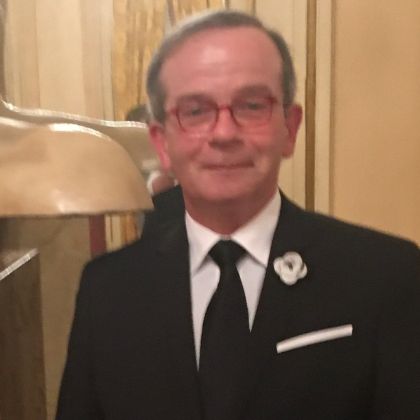The “sarcastic and scintillant” Philip Hale, music critic for three Boston dailies over the course of a 44-year career from 1890 until his death in 1934, did not like Brahms. As Symphony Hall was about to open in October of 1900, he waspishly suggested that one of the more prominent exit signs carry an addendum, “Exit- In Case of Brahms”. Were he alive today, he would be off on a two-week vacation as the Boston Symphony, a newly bearded Andris Nelsons, and Hélène Grimaud present a Brahms “mini-fest” of the four symphonies and two piano concertos. Each week’s program begins with the world première of a piece specifically commissioned to complement Brahms, followed by one of the piano concertos paired with one of two symphonies for two performances each. This week the Piano Concerto no. 1 in D minor coupled the first two symphonies.
Like much of Eric Nathan’s work, the space of a door (a title taken from Samuel Beckett’s poem, my way is in the sand flowing) is inspired by a public place, in this case Rhode Island’s Providence Athenaeum, founded in 1753 as an independent, member-supported library. On entering the building, Nathan was impressed by “the grand sight of thousands of books brightly illuminated” each one itself pregnant with latent, luminous energy and providing a “portal to another world”. The loss of his mentor, composer Steven Stucky, and a “tragic series of world events” which spun out during the piece’s composition shadowed and deepened Nathan’s original concept tied to Brahms’ bucolic Second Symphony.
This eleven-minute phantasmagoria begins with horns playing, as a fanfare, the same interval with which they open Symphony no. 2. The interval becomes a recurring harmonic motif threading through the entire piece and closing it. This quote is immediately followed by another: the C major chord which floods the stage with light when Bluebeard opens the fifth door in Bartók’s opera. The play of light continues with asynchronous strings overlapping and lending a shimmering sheen as the music blossoms into a brief, serene interlude. A sharp, frenzied passage interrupts only to yield to a rapid recapitulation of motifs from the opening. Nathan ends on a sustained note gradually dwindling like a spiral of white smoke from an extinguished candle. Nelsons and the orchestra dug into the piece with audacity and clarity giving Nathan's piece an ideal first hearing.
Nelsons and Grimaud recorded both piano concertos three years ago. That familiarity put the performance of the turbulent and impetuous First on a solid footing but did not limit it. Grimaud is an intense listener. Her response to the sounds unique to the Boston Symphony inflected her interpretation in singular ways in a performance both lithe and muscular. The Maestoso was sculpted with ample use of the damper pedal creating a grand, robust sound. A softer touch and approach vocalized the yearning of the Adagio, long thought to be an expression of Brahms’ love and affection for Clara Schumann, while the Allegro unleashed a gambolling sense of play. One early critic dismissed the concerto as a “symphony with piano obbligato”. Not so in this performance where piano and orchestra where co-equal and silver-tongued interlocutors.
The First Piano Concerto began life as sketches for a first symphony eventually abandoned. Eighteen years would pass after the concerto’s première before Brahms’ Symphony no. 1 in C minor saw the light of day in 1876. Though it pays homage to Beethoven in various ways, it’s Bach and Baroque polyphony which allowed Brahms to overcome the “anxiety of influence” and begin to find his own symphonic voice. Nelson’s pacing was deliberate yet elastic and tensile, marked by a calculated use of rubato and even a touch here and there of portamento. Overall it was a refreshingly untraditional approach flecked with outstanding solos by Concertmaster Malcolm Lowe, Principal Clarinet William Hudgins, Principal Oboe John Ferillo, and Principal Horn James Sommerville and allowing that polyphony its rightful place in the dense orchestration. A blazing account of some of the most triumphant music Brahms ever wrote closed the symphony and brought the audience to its feet.
In 1871 Giuseppe Verdi wrote to the musicologist Francesco Florimo, “Let us return to the past and that will be progress.” Brahms, an avid student of early German music from his youngest days as Schumann’s protégé, unknowingly seconded his Italian colleague by doing just that forging his own unique voice from the alloy of past and future, a voice brilliantly manifest in the works of his maturity programmed next week.


